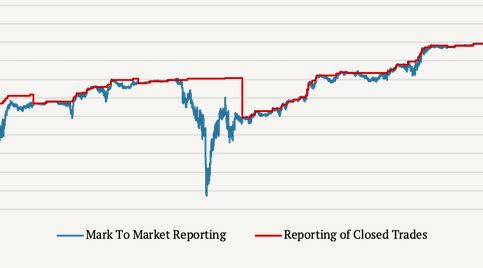Grid trading aims to take advantage of market volatility within a defined range by placing multiple buy and sell orders at fixed intervals or price levels.
Grid trading is very profitable when the market is in a range because the price tends to move back and forth within a range instead of strongly trending in one direction.

Grid trading: how does it work?
Grid trading aims to place several orders at fixed levels, usually at equal intervals, each with a fixed take-profit and stop-loss level.
Orders are triggered whenever the market moves up or down within the defined range, and profits are realised on each order closed. The grid levels can also be set sequentially as the market price moves into a new range, resulting in new trades with automatic profit and loss levels if the price moves into a new range.
A grid trade can be conducted either manually or, more commonly, using an automated trading system or bot. Despite its many challenges, automated trading should only be undertaken by experienced traders and monitored continuously and not left to trade on its own.
Pros and cons of grid trading
Pros:
Grid trading may be profitable in ranging and sideways markets, whereas other strategies may not. Grid trading involves few errors in execution so that it may be used in various markets.
A trader can profit from market volatility without predicting the direction of price movement. In addition, not having to predict future prices can reduce trading emotions.
Automating trading can help traders save time and effort and make strategies easier to follow. In addition, automation allows traders to trade multiple markets simultaneously.
Cons:
This strategy is unsuitable for those lacking discipline and patience because the profits may be marginal and take a long time to accumulate. Also, since this strategy does not require much trader input, trading can become monotonous.
Markets that are trending are not suitable for grid trading because they move in one direction quickly, and it is hard to exit your trades. However, losses can accumulate very quickly when a market breaks out of range.
How to implement a grid trading strategy:
- Select a currency pair and time frame that are suitable for grid trading.
- Set the take-profit and stop-loss levels for each order and define the price range or level at which to place the grid orders.
- You should place grid orders and monitor the market for price movement within the specified range.
- Changes in market conditions will require adjustments to grid orders.
Risk management
Taking advantage of an effective risk management strategy when trading is essential. Despite grid trading’s high winning percentage of over 60%, losses can be significant. You must use stop-loss orders, position sizing, and maximum exposure to manage risk.

Maximum Risk Exposure
To limit the risk exposure for each trade and ensure that the overall risk exposure does not exceed a certain percentage of your trading account balance, it is advisable to set a maximum risk exposure for each trade. All your positions could cost $300 if your risk per trade is $100.
Stop-loss orders
Whenever the market moves from trading a range to trending, it is essential to place a stop-loss order to limit potential losses. Therefore, you should place a stop-loss order when you enter a trade.
Position-sizing
You should also consider using position sizing to set an upper limit on each grid order so that the total amount of all open grid orders does not exceed the balance in your trading account. For example, trade one lot per entry and up to 3 lots on each grid order.
Bottom line
Trading grids in sideways or ranging markets can be profitable but requires patience, discipline, and careful risk management. However, traders of all levels can take advantage of market volatility by understanding the fundamental principles of grid trading and implementing a solid risk management strategy.

